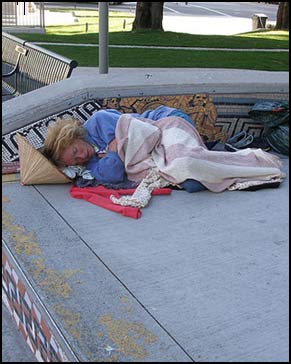
So many people are experiencing homelessness, it has become expedient and necessary to divide them into subsets. The fastest-growing category of homeless people is now women, and that includes women with children.
For practical purposes, those are two populations with very different needs, so already a barrier against easy solutions is thrown up. When it’s mother plus children, a facility needs safety plugs in the wall sockets, and a secure outdoor play area, and other amenities that single adult women do not require.
Intuitively, it would seem that adult women on their own would be easier to house. But there are other considerations. The single grownup female might fall into one or more of the other subsets: chronically ill, chronically homeless, mentally disabled, or alcoholic, to name just a few. So much care is needed.
Los Angeles made a small (relative to the need) but meaningful step with the creation of the Downtown Women’s Center, whose beginnings are described by Daniel B. Wood:
Founding director Jill Halverson became friends with a mentally ill, destitute woman and realized that in 1978, L.A.’s skid row was a man’s world and women had no place to turn. She rented a storefront and opened the city’s first day center for women, later spending her life savings on a building to permanently house 47.
A day center offers basic services like showers, clothes washers and dryers, phones, a mailing address, job counseling, and help with health problems. This particular women’s center teaches computer literacy. The DWC even offers groups where women can express themselves through art, prose, and poetry, activities which often lead to emotional catharsis, self-awareness, and psychological empowerment.
With the help of a $13 million contribution from the Conrad N. Hilton Foundation, a former shoe company building was renovated into “71 brand-new fully furnished residences, artfully appointed, with high ceilings and windows, kitchenettes, and art-adorned bathrooms.” Their aim is to help 80 chronically homeless women at a time to make the transition into permanent supportive housing. The residents, who receive Social Security or disability payments, are charged one-third of their income.
Many people are surprised to find that such institutions are extremely cost-effective. Wood says:
Nationally, the average daily cost of permanent homeless housing is $30 a day per person, compared with $1,400 a day in a hospital, $65 in a mental institution, and $129 in a state prison.
Some homeless women are spooked by the very idea of seeking an institutional bed, especially in a mixed shelter. The idea of spending the night where so many men are gathered together is frightening. You hear stories you just don’t want to believe — a church shelter where the pastor in charge raped homeless women, and one in Georgia that made news last year by turning away women they believed were gay. But the streets are treacherous, and so are the camps. It’s easy for a homeless woman to find herself in yet another subset, namely, crime victim.
Last month in Austin, Texas, Valerie Godoy was murdered. Andrea Ball looked into the local situation, speaking with many sources including Sharon Lowe of the Foundation for the Homeless, who said:
We can serve about 20 percent of the people who contact us.
That 20% means, in other words, that four out of five don’t get help. The Salvation Army has a waiting list, and other local facilities are always full. The shortage of beds, causing women to routinely be turned away, is confirmed by Richard R. Troxell of House the Homeless, who adds that after several rejections, some homeless women give up on trying to apply for a safe place to sleep. He is quoted in Ball’s article:
We’re constantly hearing from women who are being beaten or raped. No woman should be subjected to this. We need to get them off the streets now. There should be immediate emergency shelter upon request.
More than 2,700 people have signed the petition, on paper and online, demanding an emergency shelter for women in Austin. Please visit the page and become one of them.
Why should a shelter be named after Valerie Godoy? Because she was a regular person who has probably made some ill-considered decisions and bad choices along the way — as 99% of women do, every now and then. She got caught in the wrong place at the wrong time, by a very wrong person or persons. The same could be said of Princess Diana. Even though neither of them can be called typical, still by some alchemical process, both the royal celebrity and the street dweller represent Everywoman in this way.
To be female is to be vulnerable. To be a very young or a very old female is even more risky. Both fame and obscurity can expose a woman to the danger of being in the wrong place at the wrong time. And so can being a normal, average American.
Reactions?
Source: “Homelessness Besets More Women. How to Respond?,” CSMonitor.com, 12/20/10
Source: “More shelter space for homeless women needed, local advocates say,” Statesman.com, 07/13/12
Image by Quinet (Thomas Quine), used under its Creative Commons license.


